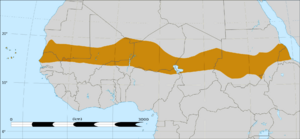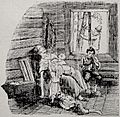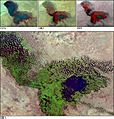Famine facts for kids

A famine happens when many people in a place do not have enough food to eat. When people don't get enough food, their bodies become very weak. This can make them very sick or even lead to death. Not getting enough food is also called malnutrition.
In poor countries, especially those that rely on subsistence farming (where farmers grow just enough food for themselves), famines can happen often. This is sometimes seen in parts of Africa.
Famous Famines in History
The Year Without a Summer (1816)
In 1816, there was a very strange year known as the "Year without a Summer." This was caused by a huge volcano erupting far away. The eruption sent a lot of ash into the air, blocking the sun and making the weather very cold. This led to crop failures and tens of thousands of people died from hunger.
The Great Irish Famine (1846-1849)
The Great Irish Famine happened in Ireland from 1846 to 1849. It was caused by a type of plant disease called Phytophthora infestans. This disease destroyed potato crops, which were a main food source for many people in Ireland at that time. Millions of people were affected, and many died or had to leave the country.
The Holodomor in Ukraine (1932-1933)
The Holodomor was a terrible famine in Ukraine during 1932 and 1933. About 7 million people starved to death during this time.
The Great Chinese Famine (1959-1961)
The Great Leap Forward in China led to what was likely the biggest famine in history. Tens of millions of Chinese people died from hunger between 1959 and 1961.
Helping During Famines
Aid groups are always looking for the best ways to help people who are hungry.
Giving Money or Food
Sometimes, giving money or special vouchers instead of actual food can be a faster and cheaper way to help. This works well in places where food is available in markets but people cannot afford to buy it. The World Food Programme, which is a big organization that gives out food, has started giving cash or vouchers in some areas. This is seen as a new and better way to help.
However, if people live far from markets or during a drought, bringing food directly might be the best way to help. It's important to get help to people quickly. If food has to be brought from far away, many people might die before it arrives.
Special Nutrients and Medicines
When people are very hungry, they often lack important vitamins and minerals. Special foods, like peanut butter sachets (like Plumpy'Nut), have changed how emergency feeding is done. These sachets can be eaten straight from the packet. They don't need to be kept cold or mixed with clean water, which is often hard to find. They can also be stored for a long time and help very sick children get better.
If malnourished children or adults also have diarrhea, they need special rehydration drinks. These drinks help replace lost fluids. It's also important for them to keep eating, even if they are sick. Doctors often recommend antibiotics and zinc supplements to help with diarrhea.
Local Solutions
Ethiopia has created a program that helps people get food by working for it or for cash. This program, called the Productive Safety Net Program, gives rural people who often don't have enough food a chance to earn it. This also allows aid groups to buy food locally from areas that have extra, and then give it to areas that need it.
The Green Revolution
The Green Revolution in the 1970s and 1980s was a big step in trying to stop famines. Scientists developed new types of crops that could grow much more food. Between 1950 and 1984, the amount of grain grown around the world increased a lot.
However, some people worry that these new crops need more chemical fertilizers and pesticides. These chemicals can sometimes harm the environment. Also, growing too much food in one place can use up groundwater or overuse chemicals, which might cause problems for farming in the future.
Images for kids
-
Skibbereen, Ireland during the Great Famine, an illustration from 1847.
-
Chinese officials helping during a famine, from a 19th-century drawing.
-
A drawing by Francisco de Goya showing starving women during a terrible famine in Madrid (1811–1812).
-
A picture showing starvation in northern Sweden during the Swedish famine of 1867–1869.
-
Lake Chad in 2001. The lake has shrunk a lot since the 1960s, affecting many people.
-
Norman Borlaug, who helped create the Green Revolution, is often said to have saved over a billion people from hunger.

See also
 In Spanish: Hambruna para niños
In Spanish: Hambruna para niños











